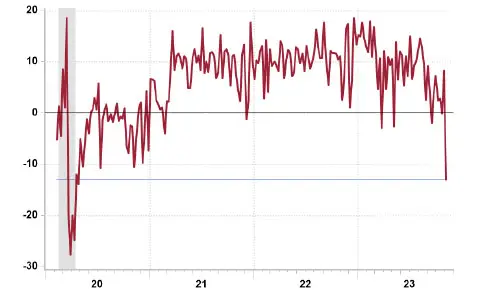Economic forecasting is essential for analysts to identify and manage significant economic risks. It involves analyzing historical data, economic indicators and using analytical tools like time series analysis, regression analysis, scenario analysis, and judgmental forecasting. While these methods are sophisticated, predicting economic trends remains inherently uncertain, similar to weather forecasting.
Importance of Economic Forecasting in Strategic Decision-Making
Economic forecasting provides critical insights that inform strategic decision-making for businesses and governments. For instance, it helps retail chains decide on new market entries by analyzing consumer spending and market conditions, enabling informed decisions about store locations and marketing strategies.
Moreover, economic forecasting is crucial for government policy-making, influencing decisions on interest rates and fiscal policies to promote economic stability and growth. Despite some limitations and the potential for inaccuracies—as evidenced by missed predictions like the 2008 financial crisis—the benefits of forecasting for preparing and mitigating major economic risks are significant.
Forecasting combines various tools to predict market behaviors and economic outcomes, helping to prepare for and address future challenges. The next sections will explore factors influencing economic trends.
Factors Influencing Economic Trends
Understanding the factors that drive economic trends is crucial for effective economic forecasting and risk management. This section explores the primary influences that shape economic conditions and market movements.
Fiscal Policy: Government spending and taxation significantly impact the economy. For example, expansionary fiscal policies, such as increased public spending and tax reductions, are often used to stimulate growth during recessions. By monitoring fiscal policy changes, analysts can predict their effects on economic activity.
Consumer Behavior: Consumer spending is a major component of GDP and an indicator of economic health. Changes in consumer confidence and disposable income can directly influence overall economic performance. For instance, increased consumer confidence typically leads to higher spending and economic growth, whereas uncertainty can lead to decreased spending and economic contraction.
Monetary Policy: Central banks influence economic trends through monetary policy, including interest rate adjustments and money supply control. Lower interest rates generally encourage borrowing and investment, stimulating economic growth. Conversely, higher interest rates can help control inflation but may also slow economic expansion.
Global Events and Geopolitics: International factors such as trade policies, political instability, and global events can also impact economic trends. These factors may affect domestic industries, exchange rates, and global supply chains, necessitating adjustments in economic forecasts and strategies.
By analyzing these factors, analysts can gain a comprehensive understanding of the dynamics that influence economic trends and develop more accurate forecasts. This holistic approach enables better preparation and strategic planning to navigate economic fluctuations effectively.
Quantitative Forecasting Methods
Quantitative forecasting methods are integral for economists and analysts to predict economic trends accurately. These methods utilize historical data, statistical models, and mathematical algorithms to identify patterns and predict future economic behavior.
Time Series Analysis: This method is particularly effective in understanding trends like unemployment rates. Analysts use past unemployment data to create models that project future trends, helping businesses and policymakers prepare for changes in the job market.
Limitations of Quantitative Methods: Despite their utility, these methods have limitations, particularly when unexpected events occur. Political upheaval, natural disasters, or technological breakthroughs can disrupt established patterns, making forecasts less accurate. For example, quantitative models were unable to predict the full impact of the COVID-19 pandemic, underscoring the need for adaptive, real-time strategies during unprecedented events.
The Case for a Holistic Approach: The debate between quantitative and qualitative forecasting highlights the need for a comprehensive approach. While quantitative methods excel at analyzing historical data and identifying long-term trends, they may not capture immediate market dynamics or the full impact of new developments.
Incorporating Qualitative Insights: Just as meteorologists use both historical data and current atmospheric readings to forecast weather, economic analysts benefit from integrating real-time qualitative data with quantitative analysis. This combined approach allows for a more nuanced understanding of economic conditions and better preparedness for sudden changes.
In summary, while quantitative forecasting methods are foundational for economic analysis, their integration with qualitative data is crucial for achieving a more accurate and complete view of economic trends. This synergy enhances the ability to anticipate and respond to economic changes effectively.
Qualitative Forecasting Methods
Qualitative forecasting methods are essential for providing insights into future economic trends that are difficult to quantify. These methods depend on subjective assessments, expert opinions, and qualitative data to forecast various economic variables, offering a necessary complement to the quantitative techniques that analyze historical data and detect patterns.
Delphi Technique: This method collects and aggregates the opinions of experts who assess economic conditions anonymously. Through several rounds of review and consensus-building, the Delphi technique refines these insights, making it particularly effective for long-term economic forecasting. This approach capitalizes on the collective wisdom and expertise of diverse professionals to forecast future economic scenarios.
Scenario Planning: In uncertain economic climates, scenario planning is invaluable. This qualitative method develops multiple potential scenarios based on different assumptions about political, technological, or social changes. Such planning allows analysts to explore various future outcomes and devise adaptable strategies, providing a strategic advantage in navigating complex and unpredictable economic environments.
Addressing Criticism: Critics often point out that qualitative methods lack the rigor and objectivity of quantitative analyses due to their reliance on subjective opinions. However, qualitative methods address areas where quantitative tools may not reach, such as assessing public sentiment, political shifts, or emerging social trends, which significantly influence economic conditions.
Practical Comparison: Think of qualitative methods as akin to a chef using intuition and creativity in cooking—a chef knows that not all aspects of creating a dish can be measured precisely. Similarly, qualitative forecasting integrates expert intuition with analytical rigor, enhancing the depth and breadth of economic analysis.
By merging qualitative and quantitative forecasting methods, analysts can leverage the strengths of both to form a more holistic view of economic trends and make more accurate predictions. This comprehensive approach not only improves forecast precision but also enriches the analytical process, enabling economists to make well-rounded and informed decisions.
Combination Forecasting Methods
Combination forecasting methods utilize both quantitative and qualitative approaches to provide a more rounded analysis of economic trends and make informed predictions. This method acknowledges that while quantitative models are insightful, they might not fully capture the subtleties and complexities that qualitative analysis can reveal.
Example of Combination Forecasting: Imagine analyzing consumer spending in a market. A purely quantitative method would analyze past sales data and macroeconomic indicators. Although useful, this might overlook new consumer behaviors or market shifts. By integrating qualitative data from consumer surveys or interviews, analysts gain insights into consumer preferences and behaviors that impact spending, leading to a more accurate forecast.
Empirical Support: Research supports the efficacy of combination forecasting. A study by economists at a prominent institute showed that forecasts combining statistical data with expert insights were more accurate than those using only one approach. This suggests that qualitative insights enhance the predictive power of quantitative models.
Practical Application: A global investment firm combines machine learning with expert analysis to predict stock market trends. This approach has proven superior to traditional methods, highlighting the competitive advantage of integrating diverse forecasting techniques.
Addressing Criticisms: Critics argue that qualitative insights might introduce bias, as they often rely on personal judgments. However, by carefully selecting a diverse group of experts and transparently blending insights, biases can be minimized, leading to more reliable and comprehensive economic forecasts.
Analogy: Consider combination forecasting as cooking a gourmet meal. Quantitative analysis provides the basic recipe and ingredients, while qualitative analysis adds unique flavors and adaptations, enhancing the dish’s appeal and complexity.
In summary, combination forecasting methods allow economic analysts to leverage both data-driven insights and human expertise, offering a deeper understanding of complex economic patterns and improving forecast accuracy. This holistic approach is crucial for navigating today’s intricate financial landscape.
By integrating both quantitative data-driven models and qualitative subjective analysis, these methods provide a more holistic understanding of economic dynamics.
Start Your FREE Trial: Get David’s Daily Insights Delivered to Your Inbox Every Morning
Embark on a journey of economic insight and investment foresight with David Rosenberg’s daily insights, delivered straight to your inbox every morning. Start your FREE trial today to gain access to invaluable market-moving events, data synopses, and Dave’s expert perspectives on the day’s investment landscape. Stay ahead of the curve, make informed decisions, and seize opportunities with timely analyses from one of the most respected voices in finance. Don’t miss out – sign up now to elevate your investment strategy and navigate the markets with confidence.


